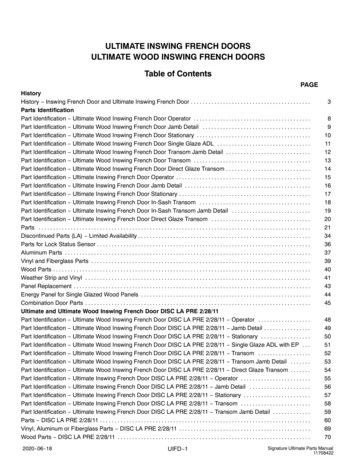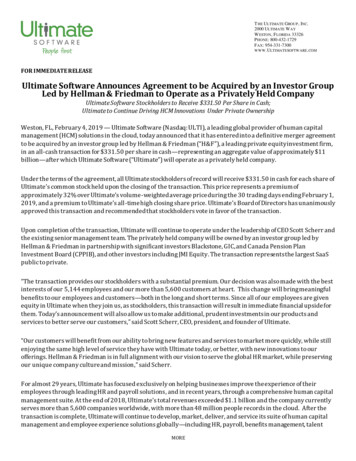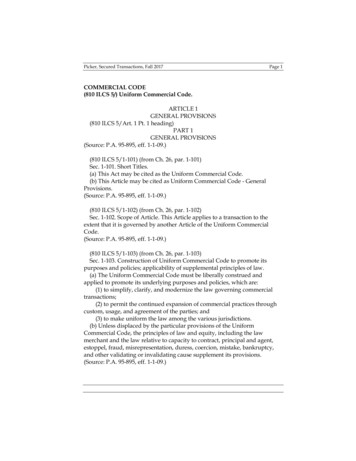
Transcription
THE ULTIMATE GUIDE TOCOMMERCIAL TANKLESSWATER HEATINGINSIGHTS ON THE FUTURE OF THIS RAPIDLY GROWING TECHNOLOGY.
TABLE OF CONTENTSIntro: The Emergence of Tankless . 3Technology Overview . 4Tankless Water-Heating Innovations . 5Flexible Water Heating for Any Project . 6Why Are Commercial BuildingsTurning to Tankless? . 7Why One Casino ResortFacility Manager Chose Tankless . 9At Ruby’s Inn, Tankless Water HeatersEnsure All Visitors Get a Hot Shower .11Project Snapshots .13Additional Resources .14
heating energy represents a significant 7 percent of all energy use in commercialbuildings. But a group of just six building types — lodging, healthcare, retail,education, food service, and office — represents about 85 percent of allcommercial building water-heating energy consumption.This e-book collects our most valuable resources on commercial tankless waterheating in a comprehensive format to make it simpler to evaluate whether thisexciting technology is right for your project. It provides an overview of tanklesstechnology basics and recent innovations in commercial systems. It includesresearch and training on why more commercial buildings are going tankless andhighlights case studies that illustrate the real-world potential of these systems.With the data and insights gathered in The Ultimate Guide to CommercialTHE EMERGENCEOF TANKLESSOVER THE PAST 10–15 YEARS, COMMERCIAL TANKLESSWATER HEATERS HAVE EVOLVED FROM AN OBSCURE ANDNOVEL OPTION TO EMERGE AS A GROWING MAINSTREAMWATER-HEATING SPECIFICATION.Tankless Water Heating, you’ll be ready to select a water-heating system thatmaximizes space, efficiency, occupant comfort, and the overall performance ofyour buildings.Water-heating energy consumption(per trillion btu) by building typeOther, 66Lodging, 136Office, 35Commercial tankless water heaters have the versatility to meet a wide range ofload types while offering reliability, energy-efficient performance, and a spacesaving footprint. They’re available in a range of capacities and can be combinedinto larger arrays for water output rates of several hundred gallons per minute.And they don’t waste energy or space keeping a large water tank hot at all hours.If architects, engineers, and building owners aren’t paying attention to the energyuse of the water-heating systems in their buildings, they’re missing out on animportant opportunity for savings, especially in certain building types. Water-Healthcare, 82Food service, 43Retail, 66Education, 68Lodging, healthcare, retail, education, food service, and office represent about 85 percent of allcommercial building water-heating energy consumption and 6 percent of the energy use in theentire commercial buildings market.3
One of the most important benefits of using tankless technology in commercialbuildings is this technology’s flexibility to meet a wide range of load types. Manycommercial tankless systems are modular, so individual tankless units can becombined to create a larger system, offering a wide range of capacity and hotwater output. The big advantage of these systems is that they remain veryefficient even when they’re running at less than full capacity. Whereas a storagetank system has to be designed for a building’s peak load and keep a full tankconstantly heated, a tankless system can rely on just a portion of the tanklessunits during off-peak times. As the hot-water demand increases, the tanklesswater heater can increase its combustion rate. When demand gets even higher,the system controller will turn on another tankless unit and share the demandacross both units.Installation and ventilation flexibilityTECHNOLOGY OVERVIEW:TANKLESS WATER HEATERSWhether a building is a hotel, restaurant, school, or brewery, building owners andoperators need to maximize space to provide key functions and services. And thedays of giant boiler rooms are over. Because they don’t store water, tankless waterheaters are very compact. And commercial tankless arrays can be free-standing,wall-mounted, installed in corner layouts, or even located outside of the building.They can even be integrated with a storage tank for easyreplacements of old tank-style water heaters.HOW TANKLESS WATER HEATERS BOOST PERFORMANCEIN COMMERCIAL BUILDINGS.Tankless water-heating systems can offer commercial buildings big improvementsin terms of performance, energy use, and energy costs. In fact, Energy Star–ratedPropane and gas tankless water heaters require venting to exhaust combustiongases, and manufacturers offer a variety of venting innovations to simplifyinstallation. For example, multiple units can use a common vent system thatreduces space needs, labor and materials, and building penetrations.tankless water heaters have the potential to use 25 percent less energy than aconventional commercial water heater.Here’s how they work.Instead of storing water, tankless systems use a heat exchanger to heat waterjust as it’s needed in a building. For example, when a guest turns on a shower in ahotel, a propane or natural gas burner in the tankless unit quickly heats up the heatexchanger. In very high-efficiency models, incoming cold water is preheated from thecombustion exhaust. Then the water continues to be heated as it passes through theunit’s heat exchanger and exits from the tankless unit at the hot-water outlet pipe,where it then flows to the shower to meet the hot-water demand.SEE THE ANIMATION.CHECK OUT OUR MOTION GRAPHICILLUSTRATING HOW TANKLESS WATERHEATERS OFFER ENERGY EFFICIENCYAND VALUABLE SPACE SAVINGS INCOMMERCIAL BUILDINGS.4
TANKLESS WATER-HEATINGINNOVATIONSa hot-water storage tank.Although tankless waterheaters have made inroadsin the commercial market inrecent years, storage tankwater heaters remain thepredominant technology inplace. Hybrid systems combinethe best of both worlds —installing just like a storageTankless water heater arraysLinking a system of multipletankless water heaterstogether used to be atime-consuming process forcontractors. But in recentyears, manufacturers havesimplified the process withtankless water heater arrays orracks: free-standing or wallmounted multi-unit systemstank for easy replacement ofold units but performing like atankless water heater with a continuous flow of hot water. That means hybrid unitsRinnai’s Demand Duo 2 hybrid water heater featuresa 119-gallon storage tank along with two tankless water heaters.provide more hot water in the first hour than other systems on the market and witha faster recovery time than a traditional storage tank system, according to Rinnai.AI, smart controls, and larger capacitiesComputerized controls allow even large tankless waterheater arrays to precisely track the water-heating load ofa building and activate individual units accordingly. Thosecontrols are what make it possible for the tankless systemto ramp up to meet a building’s peak load and then rampTankless water heater arrays can be free-standing orwall-mounted and are available with common venting systems.shipped to projects fullyassembled, including gas andwater manifolds. They are also available with common venting systems, whichfurther speeds installation by allowing the entire rack to use the same exhaustback down so just a single unit is active.and intake venting.Today, commercial tankless water heaters have joinedother building technologies in offering wireless connectivityand remote monitoring and controls. Many units offersmartphone or app-based connectivity to provide facilityIn many commercial tankless systems, the capacity of an individual tanklessunit is roughly 199,000 Btus. By combining these units in larger configurations,tankless arrays can provide hot-water output rates of several hundred gallonsper minute.Manufacturers can customize these arrays to prioritize reliability, space savings,energy efficiency, or first-hour water delivery, depending on the application,including combining tankless units with storage tanks where appropriate.That’s a vital service with different types of commercial buildings having vastlydifferent needs.Commercial hybrid water heatersA screenshot fromIntellihot’s mobile controlsdisplays hourly flow datafrom a hotel installation.managers or contractors with mobile access to their units.Tankless water heaters are even utilizing artificialintelligence. Water heater manufacturer Intellihot GreenTechnologies touts AI built into its units that analyzes a building’s hot-water usagepatterns, identifying and predicting the timing of peak loads so that the units canfire up and activate a building’s recirculation system in preparation for the higherhot-water demand. The manufacturer also offers larger on-demand systems withindividual unit heating capacity up to 3 million Btus.Commercial hybrid water-heating systems such as Rinnai’s Demand Duo combinethe on-demand, continuous hot-water supply of a tankless water heater with5
FLEXIBLE WATER HEATINGFOR ANY PROJECTHERE ARE A FEW EXAMPLES OF HOW PROPANE TANKLESS WATERHEATERS CAN SOLVE YOUR WATER-HEATING CHALLENGES.Small restaurantModest demandCollege residence hallMedium demandPrimary concerns: Space savings,performanceHot-water needs: Sinks, dishwashers,cooking, bathroomsChallenges: Meeting high supplytemperatures required by code with tightspace constraintsSolution: 1 high-efficiency tanklesswater heaterResult: A 96% efficient unit provides140-degree water for dishwashing andcooking with no drop-off in capacity, and itcan be installed outside or tucked away witha wall mountMid-size hotelPrimary concerns: Efficiency, performanceHot-water needs: Shower and bath facilitiesfor 120 residentsChallenges: Efficiently meeting highpeak demand alongside extendedpartial-load periodsSolution: 3 high-capacity tanklesswater heatersResult: With a total capacity of 750,000 Btus,this array can easily modulate to meet highdemand periods without the standby losses ofstorage tank water heatersVacation resortHigh demandPrimary concerns: Efficiency,space savingsHot-water needs: 130 guest rooms,restaurant, laundryChallenges: Efficiently meeting high peakdemand with tight space constraintsSolution: 17 tankless water heaters in 3 arraysResult: By combining wall-hung tankless unitsinto arrays with common vents, the systemcan fit into a tight mechanical space whileensuring an efficient water supply that meetspeak demandPrimary concerns: Performance, reliabilityHot-water needs: 700 guest rooms, 3restaurants, large laundry facilityChallenges: Meeting high peak demand soguests don’t experience cold showersSolution: 175 tankless water heatersResult: Rather than the expense of heatingenormous hot-water storage tanks, a largeresort can efficiently meet demand whenneeded and have peace of mind knowingguests are happyVery high demand6
WHY ARECOMMERCIAL BUILDINGSTURNING TO TANKLESS?When the 130-room Residence Inn by Marriott in Florence, Alabama, wasreplacing its water-heating system in a renovation, the original replacementsystem specification called for two 750-gallon boilers, each measuring 5 feet by12 feet. The plan would have almost worked — it left a few inches of clearancein the boiler room — but with so little space, maintenance would have beenimpossible without shutting down the entire water-heating system.So the hotel changed course, implementing a 17-unit gas tankless water heaterarray that provided enough space in the mechanical room to service the units.Plus, there were energy-efficiency benefits: The new design eliminated the energylosses from storing 1,500 gallons of hot water, reducing energy use for the hotel.As the hotel’s successful renovation shows, propane and gas tankless waterheaters offer an innovative opportunity to provide energy-efficient water heatingwith flexible system designs that can be tailored to a building’s space constraintsand hot-water demand.A new training course from engineering consultants Newport Partners LLC andthe Propane Education & Research Council, “Propane Tankless Water Heating inCommercial Building Applications,” offers insights into how commercial buildingprofessionals can use tankless systems to maximize a building’s water-heatingperformance for both existing buildings and new construction. And becausevirtually all tankless water heaters can run on readily available propane, they’re anoption even for projects that lack access to natural gas.Contractor Anthony Crouch, owner of Crouch & Sons Plumbing in Florence, Alabama, examines theResidence Inn by Marriott’s tankless water heater array with distributor Jason Veal of the Tallman Company.Photo credit: Randy Crowcombined together in racks or arrays to provide a range of water-heating capacityand output. That means a system could be designed for a large peak load thatrequires several hundred gallons per minute of hot-water output but still respondwell when only a small portion of that hot water is needed.Hotels are a particularly common use case for this strategy, says Jamie Lyons, asenior consultant with Newport Partners. “Even though the peak demand for hotwater happens really infrequently, they still have to be ready for it or else they haveunhappy customers,” he says. “The value proposition for tankless there is reallystrong because you can use an array of tankless units that can ramp up to meetthe peak when it happens, even if it only happens a really small percentage of thetime. You’re ready for it, but you’re not storing hundreds or thousands of gallons ofhot water all the time.”Flexibility for peaks and low pointsOne of the primary benefits the course highlights is the flexibility of tanklesswater-heating systems to meet a variety of water-heating loads. Many commercialtankless water-heating systems are modular: Individual tankless units can be7
“ YOU CAN USE AN ARRAY OF TANKLESS UNITS THAT CANRAMP UP TO MEET THE PEAK WHEN IT HAPPENS,EVEN IF IT ONLY HAPPENS A REALLY SMALL PERCENTAGEOF THE TIME.”— JAMIE LYONS, SENIOR CONSULTANT, NEWPORT PARTNERSThe Residence Inn by Marriott in Florence, Alabama, used a 17-unit gas tankless water heater array to savespace in the mechanical room and allow room to service the units.Instead of simply keeping water hot in a large storage tank, tankless systems usesophisticated controls to modulate the heating capacity of an individual unit higheror lower to meet the demand for hot water. When additional capacity is needed,the system can bring on additional units to share the load and increase output. Thecontroller also spreads the duty cycle out so that one unit won’t wear out beforethe rest.At the Residence Inn by Marriott, for instance, the 17-unit tankless array includes 12units to supply hot water to the 130 guest rooms and five units for the hotel’s dining“Even on the new-construction side, we saw one or two projects where thephysical footprint was a sticking point,” he says. “They want to maximize thespace in the building that’s providing key services or generating revenue, asopposed to just creating space for boilers or water heaters.”While providing ventilation for 17 tankless water heaters might sound messy,common venting options are available that save space and reduce wallpenetrations. The Residence Inn by Marriott used common-vent runs fortwo banks of water heaters and had one standalone unit. “So they ended upwith three building envelope penetrations and venting runs instead of all 17,”Lyons says.The course highlights the diversity of tankless product offerings available from aand laundry operations. Each tankless unit has a capacity of just under 200,000Btus per hour. Because each individual tankless unit can modulate as low as 11,000variety of manufacturers. That includes many at efficiency levels high enough tomeet the prescriptive requirements or energy-modeling savings needed for LEEDBtus per hour, the overall system has a huge capacity range from over 3 milliondown to 11,000 Btus per hour.v4 for Building Design and Construction. “Most, if not all, of these natural gastankless water heaters are convertible to propane, so the offering’s pretty broad,”Lyons says.More space to do businessThe training course also covers important considerations for the size andventilation considerations of a building’s water-heating system. Because boilersand tank-style water heaters store water, they have a larger physical footprintthan tankless units, which can be arranged in self-supporting racks or wallmounted, depending on project needs. While it’s unsurprising that those spacesavings can benefit a retrofit project like the Residence Inn by Marriott, thatTo learn more about the contributions that tankless water heaterscan make toward LEED certification and see more project examples,check out “Propane Tankless Water Heating in Commercial BuildingApplications” in the Propane Training Academy.flexibility can be helpful in new construction as well, Lyons says.8
“Our job is to provide a nice, comfortable environment for our guests,” Halstedsays. “We’re open 24/7. We have a lot of restaurants; we need hot water to cleandishes with. Whether it’s the heating, the hot water, or air conditioning, we alwayshave some kind of built-in redundancy so our guests are not affected.”With three tanks, at least two of the systems needed to be running full time, soan outage in any of the units could put performance in jeopardy. The new Rinnaitankless array typically uses only about half of the units, providing the uptimeand reliability the facility manager requires.Readily available and affordableUpgrading to a tankless array wouldn’t have been possible, however, withoutpropane, which provides energy for dozens of applications throughout the resort.Pala was opened in 2001 by the Pala Band of Mission Indians, becoming the firstbrick-and-mortar tribal casino built in the area. The casino is located on rural triballands in the Palomar Mountain area, about 60 miles north of San Diego.A propane tankless array serves all of the casino’s potable hot-water needs, from the dishwashers to the restrooms.WHY ONE CASINORESORT FACILITY MANAGERCHOSE TANKLESSRunning natural gas from the main several miles away would be too costly. Andelectricity can’t meet the enormous hot-water and heating demands of a resortwith a Las Vegas–style casino, 507 hotel rooms, a 10,000-square-foot spa, and40,000 square feet of meeting and convention space. Instead, the resort relies onreadily available propane for the water heating and other critical needs. “Propaneis the least expensive versus electric,” Halsted says. “We’ve got a lot of water we’reheating. I couldn’t imagine the size of an electric water heater that we would beusing.” Plus, the resort has several peak demand periods each year when the priceof electricity skyrockets.“We get affected by thatpretty drastically justwith what we’ve got,” hesays. “I couldn’t imagineThe Pala Casino Spa and Resort prides itself on luxurious hospitality and worldclass amenities. And as director of facilities, Bob Halsted plays an importantrole in ensuring the casino’s guests have an exceptional experience — with nounexpected problems.if we used electricity todo heating and hot wateralso here, what we wouldbe facing on those days.”So when the Southern California casino’s three water heaters began to showsigns of age, Halsted saw an opportunity to improve the hot-water system’sreliability and performance while also reducing energy costs. Instead of threelarge tanks, Halsted turned to a large array of 19 propane-fueled tankless waterheaters to ensure the hot-water system never experienced downtime.As the Pala Casino Spa and Resort grows for the future, tankless waterheaters provide the uptime and reliability every facility manager craves.9
Amenities without sacrificesThe propane tankless array serves all ofthe casino’s potable hot-water needs,CHEF’S SECRET WEAPONfrom the dishwashers to the restrooms.Propane boilers provide heating hot waterto fan coil units, allowing the casino’soffices to control temperature individually.Guaranteeing guests’ comfortmay simply be table stakesin the casino and hospitalityindustry, but Pala’s otheramenities help it truly standout from the competition. Theresort’s 11 restaurants areanchored by Choices, the largestbuffet in Southern California at630 seats, and the Oak Room, ahigh-end, elegant dining roomfocusing on steaks and chops.The Oak Room’s secret weapon?A 1,600-degree propane grill.“Our high-temperature grillsears the meat and seals in theflavors,” says Robert Camerota,Pala’s executive chef. “A regulargrill would only cook the meatat around 500 degrees. The1,600-degree grill sets theflavor at an entirely new level.”The casino floor uses propane rooftoppackage units for heating. And in thehotel, four separate propane boilersprovide domestic hot water to the guestrooms. The laundry room includes twolarge propane commercial clothes dryers.All of the resort’s pools and spas areheated by propane, including a pool andtwo hot tubs at Pala’s new RV resort. Theresort opened in May 2016 and has beensold out every week after winning BestRV Resort Casino and Best CampgroundResort awards from Trailer Life andMotorhome magazines.This July, Pala announced a 170 millionrenovation and expansion that will adda 349-room hotel tower, convert theexisting resort pool into a multi-pooland entertainment resort complex, andrefresh other resort spaces. Like thetankless water heater upgrade, the projectwill ensure the resort not only meetsguests’ expectations but also attractsnew visitors for years to come.All of the Pala Casino Spa & Resort’s pools and spasare heated by propane, including a pool and two hottubs at Pala’s award-winning RV resort.10
With that much demand, the resort’s old water-heating system was under a lotof strain.“We’ve got some unique challenges in that a lot of our business is tour buses andthey show up late at night and the first thing they want to do is all shower,” saysLance Syrett, general manager of Ruby’s Inn. “Historically, that’s always been aproblem because you just can’t keep up with 40 showers at the same time.”Avoiding a negative guest experienceOne of the primary issues with the resort’s water-heating infrastructure was alack of redundancy in its boilers. If a unit went down, the resort could go for upto two hours without hot water. The negative impact on the guest experiencewas clear — and costly. “Our goal is a reduction in the discounts we have to give,”says Ron Harris, manager of Ruby’s Inn. “Or we have to completely refund a roomand sometimes an entire building block because they took a cold shower in themorning. We look at about 60,000 a year in discounts and refunds.”Ruby’s Inn management brought in tankless water heater manufacturer Rinnai’sUsing more-efficient tankless water heaters, Ruby’s Inn is projected to save 6,000 a month in propane costs.AT RUBY’S INN, TANKLESSWATER HEATERS ENSURE ALLVISITORS GET A HOT SHOWERFor most hotel operators, tour buses full of guests showing up to check in would becommercial water-heating team to assess the problem. With the help of propaneprovider Blue Star Gas, Rinnai designed a customized system for the resort, witha plan for every building. The plan highlighted the efficiency and reliability ofswitching to a tankless water-heating system.“Rinnai as well as Blue Star came back with a 30 percent savings, which calculatedback on the fuel savings, would have been 7,000 gallons of propane per month,”says Steve Rutherford, division manager for Blue Star Gas.The solution ultimately included 175 new propane tankless water heaters, 35tankless rack systems, and four Demand Duo hybrid commercial water-heatingsystems. With the more-efficient tankless units in place, Ruby’s Inn is projectedto save 6,000 per month on propane alone. And perhaps just as importantly, thea great sign of a healthy property with low vacancy.resort has had no issues with hot-water supply or customer complaints, freeingstaff time and money for other efforts at the resort.But at Ruby’s Inn, a major resort and tourist destination located near Bryce Canyonin Utah, an aging water-heating system made those tour buses a source of anxiety.The resort includes 19 buildings, 700 hotel rooms, three restaurants, an RV park,“There’s no commercial business that can keep their doors open without hot water,so the reliability and the redundancy of a tankless water-heating system is reallykey to any business owner,” says Brian Watts, senior commercial business managera campground, three swimming pools, and a laundry facility that does 19 tons oflaundry per day. On any given night, the resort could have up to 4,000 guests onthe premises.for Rinnai.11
History of stewardshipRuby’s Inn was founded in 1916 by Lance Syrett’s great-grandfather Reuben“Ruby” Syrett, who bought the land sight unseen before Bryce Canyon became anational park. “He went up there and saw that with his wife and his two children,and they said, ‘This is absolutely beautiful, and we think people are going to want tocome see this someday,’” Lance Syrett says.Ruby Syrett got permission from the state of Utah to build a facility at the rim ofthe canyon called “Tourist Rest.” In 1923, when Bryce Canyon became a nationalmonument, Ruby Syrett moved Tourist Rest to the location of the ranch and namedit Ruby’s Inn. Over time, the inn grew to include multiple hotels, restaurants, andthe RV park and campground.Even today, however, Ruby’s Inn remains on the frontier, with no natural gas linewithin 25 miles. In the place of natural gas, the resort has relied on propane for itswater heating and other energy needs.“I believe that this entire property exists because of the propane option,” Wattssays. “It’s great working with the propane along with our product to get them themost-efficient water-heating system on the market.”Propane also serves as a clean form of energy for Ruby’s Inn, which prides itselfon being a steward of the environment at Bryce Canyon. “We like to think we’regood stewards of the national park,” Lance Syrett says. “We give back; we’ve got alot of programs. We try to be as environmentally conscious as we can be. And thispartnership with Blue Star Gas and with Rinnai is just another rung in that ladder.”ruby’s inn remains on the frontierwith no natural gas line within 25 miles.IN THE PLACE OF NATURAL GAS, THE RESORTHAS RELIED ON PROPANEFOR ITS WATER HEATING AND OTHER ENERGY NEEDS.CHECK OUT THE RUBY’S INN VIDEOON PROPANE.COM TO SEE HOWRUBY’S INN WORKED WITH RINNAI ANDBLUE STAR GAS TO OVERHAUL ITSWATER-HEATING SYSTEM THROUGHOUTTHE 19-BUILDING PROPERTY.12
Sutton Hall — Milligan College, TennesseeThis 64-room, 120-residence halloriginally used an 80-gallon, 199,000Btu/hour tank water heater coupledwith two 100-gallon storage tanks. Butthe system experienced frequent leaks,inefficient operation, and inconsistencyin being able to meet the building’sdemand. The school replaced theold system with a bank of three tankless units from the manufacturer Intellihot.The total capacity of these tankless systems is 750,000 Btus per hour, providingenough heating capacity to meet peak load while not actually storing any water.Residence Inn by Marriott — Florence, AlabamaA renovation for this 130-room hotelincluded a new water-heating system,which was initially specified to includetwo 750-gallon, 750,000 Btu/hourboilers to provide hot water to thehotel. However, the hotel’s mechanicalroom could barely accommodate thetwo boilers, leaving just a few inchesof clearance between the units and the surrounding walls. Instead, a 17-unit,wall-hung tankless array provided space savings and enough space within themechanical room for servicing the units.PROJECT SNAPSHOTSTomato House Restaurant — Senoia, GeorgiaWith an older tank water heater, thisrestaurant could not reliably producehigh-enough temperatures to meethealth code standards. The not-Available in the Propane Training Academy, the “Propane Tankless Water Heatingin Commercial Building Applications” training course highlights several additionalproject examples. Check out the course to learn more about how these buildingsused tankless water heaters to meet high peak demand needs, reduce standbyenergy losses, and save space used for mechanical equipment.so-hot water also meant it took 30minutes to get water to boil, slowingdown the kitchen. Plus, space wasvery tight. So instead of a largertank, the restaurant selected a 96-percent-efficient tankless unit that provides140-degree water with no drop-off in capacity — and the small unit could beinstalled in the ceiling to free additional space.13
ACCESS ADDITIONALRESOURCES AT PROPANE.COMThe capabilities of propane in commercial buildings extend far beyond tanklesswater heaters. Visit propane.com to explore propane’s flexibility in meeting nearlyall of a building’s energy needs.VIRTUAL COMMERCIAL BUILDINGSTour our interactive Virtual Commercial Buildings to see propane applicationsfor your project type.FREE CONTINUING EDUCATION CERTIFIED TRAININGBoost your bottom line by taking one of our free online propane training courses andearn credits from the American Institute of Architects continuing education systemand the Green Business Certification Institute.BUILD WITH PROPANE NEWSLETTERSign up for the commercial edition of the Build With Propane newsletter to stayinformed on the latest news, techniques, and incentives for propane building.SUBSCRIBE ON YOUTUBEDon’t miss the latest videos featuring commercial case studies, new technologies,and interviews with construction and facilities professionals.E-BOOKS AND GUIDESClick to download any of our growing collection of valuable e-books and guides.Build With Propane Guide:Commercial EditionThe Ultimate Guide toCommercial Propane ApplicationsThe Ultimate Guide to TanklessWater Heaters, Volume 1Build With Propane Guide:Reside
Rinnai's Demand Duo 2 hybrid water heater features a 119-gallon storage tank along with two tankless water heaters. Tankless water heater arrays can be free-standing or wall-mounted and are available with common venting systems. A screenshot from Intellihot's mobile controls displays hourly flow data from a hotel installation.











